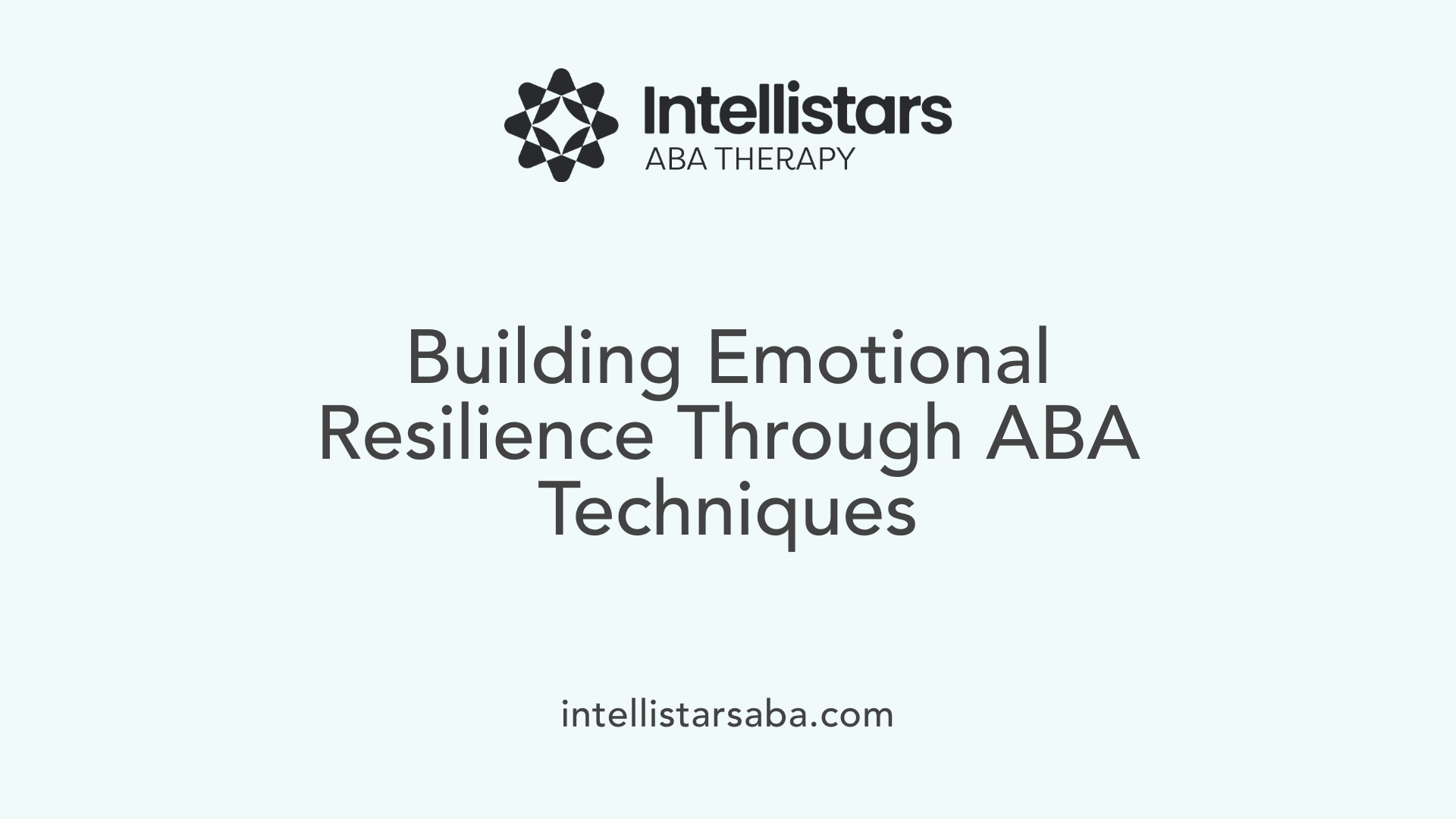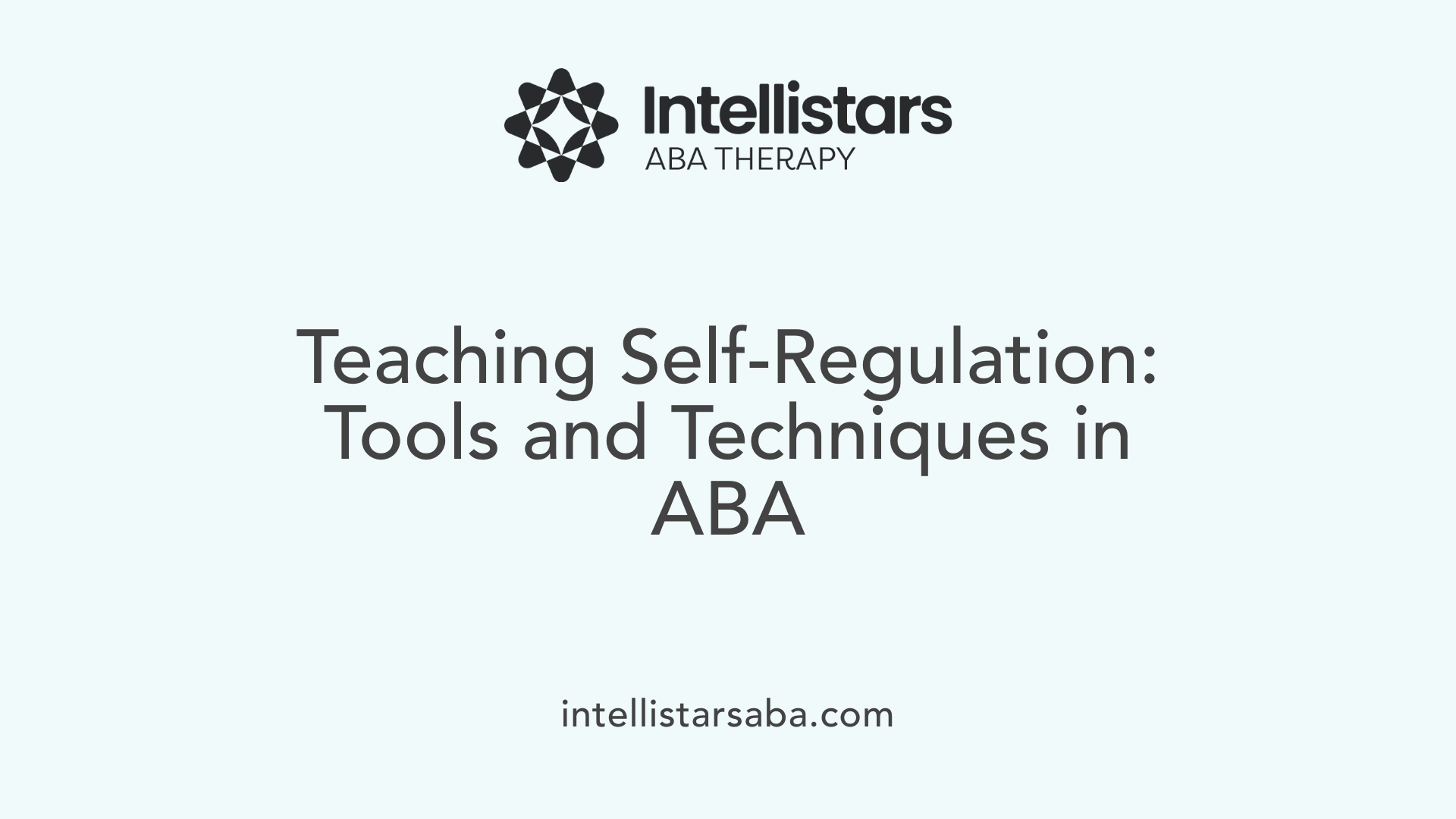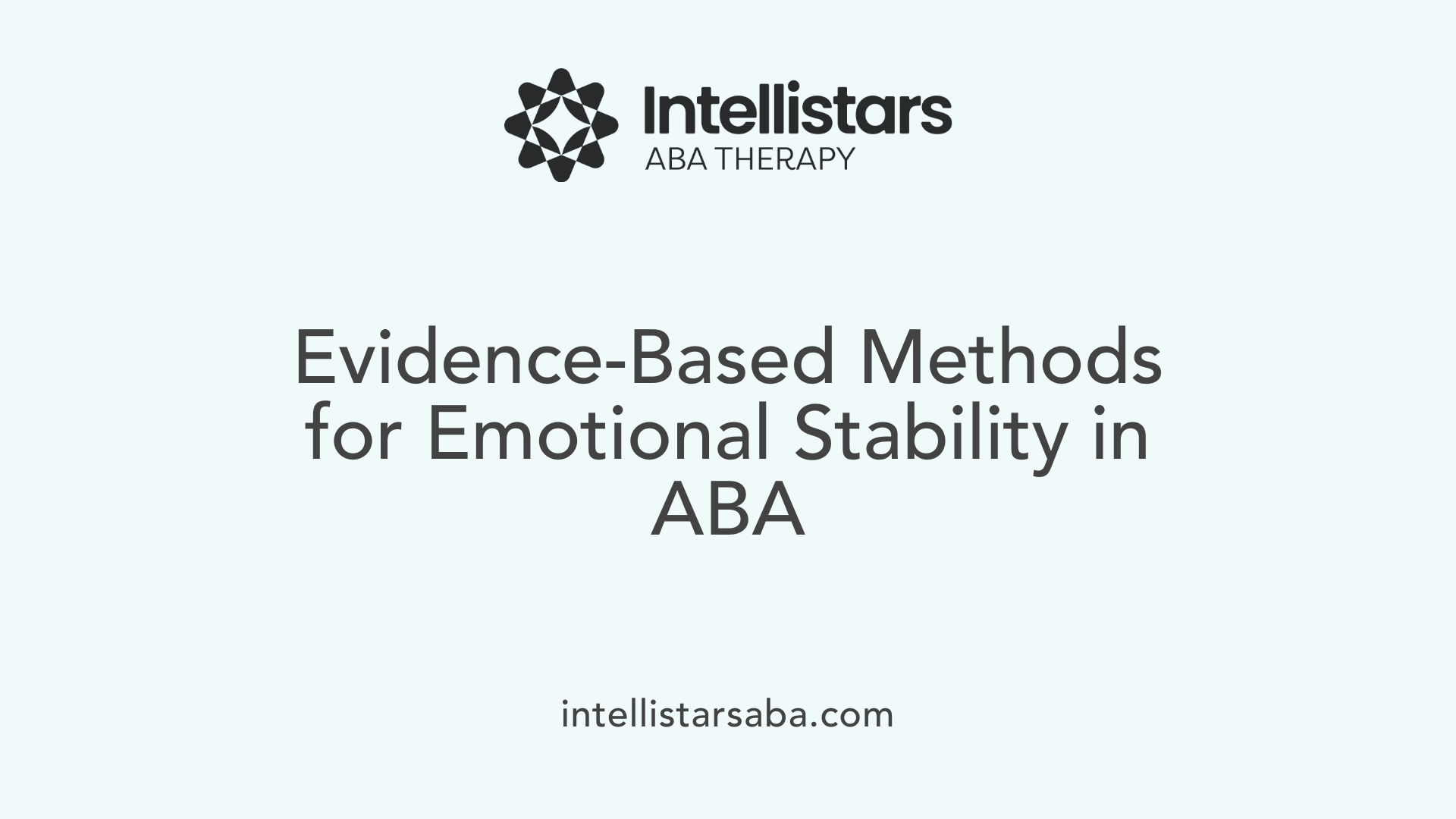Understanding ABA's Role in Emotional Regulation
Applied Behavior Analysis (ABA) is a scientifically-supported approach widely used to help children, especially those with autism or ADHD, develop essential emotional regulation skills. By utilizing structured, individualized strategies, ABA fosters awareness, understanding, and control of emotional responses, promoting healthier social interactions and reducing disruptive outbursts.
Core Strategies in ABA for Emotional Regulation

What are the strategies used in ABA therapy to promote emotional regulation in children?
ABA therapy employs a broad range of practical techniques aimed at helping children recognize and manage their emotions effectively. One of the foundational methods involves teaching children to identify and label their emotions using visual aids such as emotion cards, social stories, and visual supports. These tools help children understand different feelings and the situations that trigger them.
To build emotional resilience, therapists incorporate activities like deep breathing, sensory activities, and calming techniques. These are often taught through structured task analysis, video modeling, and rehearsal with role-playing. Reinforcement plays a vital role; children are encouraged with praise, preferred activities, and positive feedback when they use coping skills or demonstrate self-regulation behaviors.
Modeling and role-playing allow children to practice appropriate responses in a safe environment. For example, children might rehearse asking for a break or calming down when upset. These activities help translate learned skills into real-world situations.
Customization is essential in ABA. Therapists evaluate each child's unique triggers—such as loud noises or fast demands—and develop tailored interventions like noise-canceling headphones or designated quiet areas. Strategies like teaching replacement behaviors, using visual supports, and encouraging self-monitoring enable children to anticipate their reactions and intervene proactively.
Overall, ABA's evidence-based approaches focus on breaking down emotional regulation into manageable components, fostering skills that promote independence, calmness, and better social interactions over time.
Goals and Tools of ABA for Emotional Regulation Development
What are the goals and tools of ABA therapy for developing emotional regulation?
ABA therapy aims to help children learn how to recognize, understand, and manage their emotions effectively. The ultimate goal is to reduce emotional outbursts and frustration, enabling children to respond to their feelings in healthier ways.
To reach these objectives, ABA employs a variety of evidence-based strategies. Visual supports such as social stories, emotion cards, and stoplight visuals play a crucial role in helping children identify and communicate their feelings.
Modeling behaviors and role-playing provide opportunities for children to rehearse appropriate responses in a safe environment. Discrete trial teaching (DTT) and behavior skills training (BST) further enhance these skills through structured instruction, prompts, and reinforcement.
Reinforcement, including praise and preferred activities, is used to encourage calm and adaptive behaviors. Positive reinforcement is particularly effective if it’s immediate and specific, ensuring children associate good regulation with positive outcomes.
Play-based, naturalistic teaching approaches are incorporated to increase motivation and facilitate the generalization of skills across different settings. These methods often involve fun, engaging activities that promote emotional and behavioral flexibility.
Progress monitoring through data collection allows therapists and families to track behaviors, triggers, and growth over time. Adjustments to strategies are made based on this data, ensuring personalized and effective intervention.
Overall, ABA combines structured teaching with playful and naturalistic methods, creating a comprehensive approach to nurturing emotional regulation and social skills. This helps children develop confidence in expressing and managing their emotions, leading to better social interactions and emotional well-being.
Techniques for Teaching Self-Regulation and Managing Emotions

What techniques does ABA therapy use to teach children self-regulation and manage emotions?
ABA therapy employs a variety of approaches to help children learn how to regulate their emotions effectively. Visual supports are fundamental tools, including photographs, icons, videos, and color-coded visuals like stoplight images, which assist children in recognizing and understanding their emotional states. These visual aids make abstract feelings more concrete and accessible.
Another important method is discrete trial training, which systematically teaches children to identify and express emotions by using prompts that are gradually faded as skills develop. This structured approach ensures children learn to recognize specific feelings and respond appropriately.
Behavior Skills Training (BST) forms a core part of emotional regulation strategies. It involves step-by-step instruction, modeling expected behaviors, rehearsal through practice, and providing feedback. This cycle reinforces calm, positive responses such as deep breathing, asking for breaks, or counting during stressful moments.
Modeling behaviors is also extensively used. Therapists demonstrate calm responses and label emotions to help children understand what they are feeling. For example, saying, 'I’m feeling frustrated and need to breathe,' provides a clear example for children to imitate.
Supporting these methods are practical tools like social stories, Hard Times Boards, and personalized calming kits. These resources help children identify triggers and learn specific coping strategies, encouraging independence in managing emotions.
ABA emphasizes teaching self-management skills, including self-awareness, self-monitoring, and self-instruction. Visual aids and reinforcement are used to motivate children to recognize their emotional states and apply appropriate regulation techniques.
Proactive strategies such as visual schedules, offering choices, and teaching the use of break cards are also employed. These tools contribute to reducing emotional outbursts by helping children anticipate and prepare for challenges, thereby promoting more adaptive responses across various environments.
Overall, these evidence-based techniques work synergistically to develop children’s ability to understand, manage, and communicate their emotions effectively, fostering greater independence and emotional resilience.
Applying Evidence-Based Methods to Foster Emotional Stability
 ABA therapy offers a comprehensive approach to helping children develop emotional regulation skills by using proven strategies grounded in behavioral science.
ABA therapy offers a comprehensive approach to helping children develop emotional regulation skills by using proven strategies grounded in behavioral science.
One foundational method is the use of Functional Behavior Assessments (FBA). These assessments allow therapists to identify specific environmental triggers that cause emotional outbursts or dysregulation. For example, loud noises or high demand tasks might lead to frustration. By understanding these triggers, therapists can tailor interventions to minimize their impact.
Positive reinforcement plays a vital role in encouraging children to exhibit goal-directed emotional behaviors. When a child manages their emotions successfully, they are praised or rewarded with preferred activities, thus strengthening their emotional regulation skills.
Visual supports such as emotion cards, social stories, and visual cues like stoplight visuals are instrumental. These tools help children recognize, label, and communicate their emotions effectively. Modeling appropriate responses and engaging in social skills training through role-playing create real-world practice, teaching children how to respond calmly in various situations.
Beyond cognitive strategies, relaxation techniques like deep breathing, mindfulness practices, and structured routines assist children in calming down when they feel overwhelmed. These methods help reduce stress and promote emotional resilience.
Involving parents in therapy is crucial. Parent training programs teach consistent reinforcement strategies at home, ensuring that emotional regulation skills are reinforced in multiple settings. This consistency is essential for generalizing skills, making emotional stability a sustainable outcome.
In summary, ABA combines assessment, reinforcement, visual tools, modeling, relaxation, and family involvement to systematically support children in managing their emotions and reducing outbursts.
Integrating Emotional Regulation in Daily Life and Generalization of Skills
 In ABA therapy, the use of visual supports and social stories plays a vital role in helping children practice emotional recognition and management in real-world settings. Visual aids such as emotion cards, stoplight visuals, and social stories illustrate everyday situations, guiding children to understand and respond appropriately to different emotional experiences.
In ABA therapy, the use of visual supports and social stories plays a vital role in helping children practice emotional recognition and management in real-world settings. Visual aids such as emotion cards, stoplight visuals, and social stories illustrate everyday situations, guiding children to understand and respond appropriately to different emotional experiences.
To prevent emotional triggers, environmental modifications are crucial. These may include providing noise-canceling headphones, creating calm-down corners, or reducing sensory overload by adjusting lighting and sounds. Such changes help reduce anxiety and minimize outbursts, making it easier for children to regulate their emotions.
Caregiver training and naturalistic teaching methods are essential components of successful ABA implementation. Parents and caregivers learn to reinforce skills at home, apply consistent strategies, and create supportive environments. This approach encourages skill generalization, ensuring that children use their emotional regulation techniques across various settings.
Self-monitoring tools, like emotion checklists or visual cues, empower children to recognize their triggers and implement coping strategies proactively. Techniques such as deep breathing, requesting breaks, or engaging in calming activities help children manage their reactions before escalation.
Consistency and reinforcement across different environments enhance progress. Regular practice with visual supports, combined with positive reinforcement for appropriate responses, strengthens new behaviors. Fading prompts gradually and using reinforcement schedules maintain these skills over time.
By integrating these strategies—visual aids, environmental adjustments, caregiver involvement, proactive coping, and consistent reinforcement—ABA therapy fosters resilient emotional regulation. These methods help children navigate daily challenges confidently, setting a foundation for ongoing emotional growth and adaptability.
Building a Foundation for Long-Term Emotional Well-being
Implementing ABA techniques to encourage emotional regulation provides children with vital skills that impact their overall well-being and social success. By combining visual supports, positive reinforcement, modeling, and structured practice, ABA helps children recognize, understand, and manage their emotions effectively. Parental and caregiver involvement ensures these skills are reinforced across all settings, fostering emotional resilience and adaptability over time. Through consistent application and data-driven adjustments, ABA therapies pave the way for sustainable emotional growth and improved life quality for children with autism and ADHD, empowering them to navigate their emotional worlds with confidence.
References
- Teaching Children to Self-Regulate Their Emotions - ABA Therapy
- From Meltdowns to Calm:ABA Therapy Strategies for Managing ...
- How ABA Therapy Supports Emotional Regulation
- Teaching Emotional Regulation with ABA Tools
- Simple Evidence-based Strategies for Teaching Emotion Regulation
- Simple evidence-based strategies for teaching emotion regulation?
- Developing Effective Self-Management Skills in ABA Programs
- ABA Therapy for Emotional Regulation: From Meltdowns to Mastery
- Simple evidence-based strategies for teaching emotion regulation?






